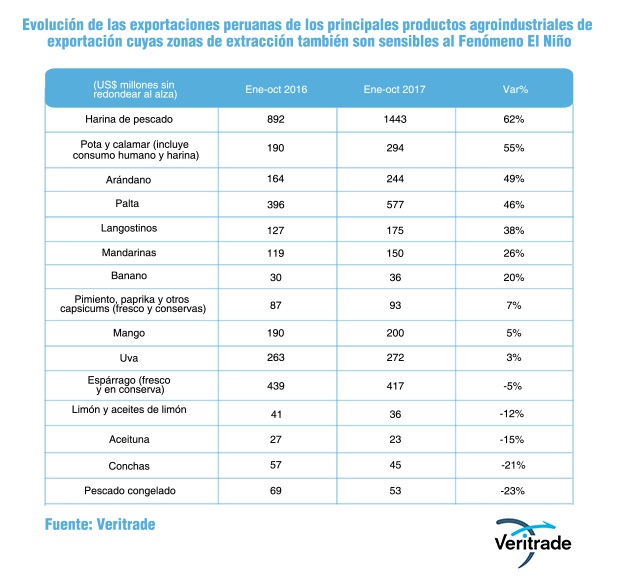Exports Peru: El Niño hit little.
Published on 08 January 2018
Impact of El Niño Costero Phenomenon on agricultural and fishing exports has been moderate, and it would have a surplus in 2018.
In 2017, Peru experienced an alteration in temperatures and rainfall levels only comparable to those observed in 1983, when there was still no modern agro-industry, and in 1998, when only the asparagus had been developed. The El Niño Costero Phenomenon was the first opportunity to assess the resilience of the country's agro-industrial and fishing matrices to major weather events, and the impact is undoubtedly felt. Next, we observe the variations in the exports of each of the main non-traditional products extracted on the coast, according to information from Veritrade.

Fortunately, even the aggregate impact on Peruvian agribusiness and fishing has not been very high, and only slight falls are observed in asparagus, olives and lemons, in the first two cases, due to the cold dependence at night. This demonstrates the resistance of most crops, although it shows that businesses linked to agro-export must model the periodic occurrence of a large-scale weather phenomenon in a given time horizon. However, with a view to 2018 (and even from October 2017, if the current grape campaign is taken into account), it is expected that there will be a 10% drop in the export of grapes (in terms of value, about US $ 50 million, double the decline in asparagus production this year).
On the fishing side, it is expected that the volume of fishmeal production will be lower due to an anchovy extraction quota (1.49 million MT for the second season, compared to 2 million in 2016). In the counterpart, the harvest of fan shells could recover, given that they reach adulthood at 370 days of life.
In general, there is a balance that can be considered positive in comparison to more pessimistic projections, and above all, a learning of what has been the first El Niño phenomenon of great magnitude in Peru's modern non-traditional agro-export and fishing era. In view of what happened in 1983 and 1998, and the warnings issued regarding phenomena that ended up being of lesser magnitude in 2011 and 2015, it makes sense to think of an atypically bad year per decade when projecting cash flows.
On the other hand, if weather conditions remain normal, 2018 should be a good year to acquire stocks of asparagus, fish for direct human consumption and fan shells. In the counterpart, one would have to see what are the prospects for prices in external markets. Check with your brokers.
Learn more about Veritrade, and the foreign trade data that you could obtain, to analyze the data and plan to plan for the future.
Login to https://bit.ly/2qjt1x8 and request your free trial.